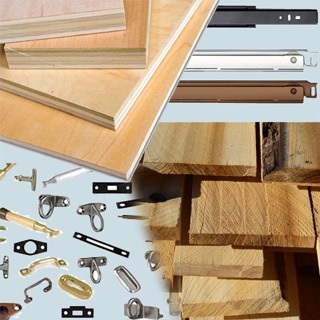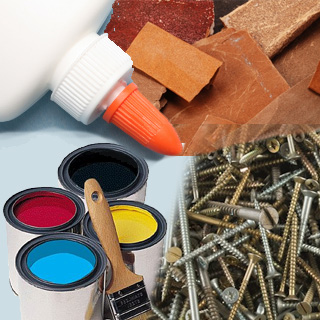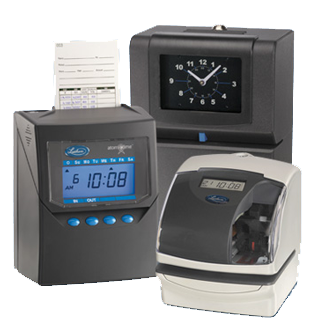Pricing - A Guide To Establishing A Price For Your Crafts
 Whether you are a hobbyist woodworker or a seasoned professional, setting the price for an item you have completed or plan to fabricate can sometimes seem like a form of black magic. Some of you may have seen formulas that base your price solely on the cost of materials multiplied by a certain factor. This may work for some of you, but for most of us, doing a more elaborate calculation may uncover opportunities to be more competitive and possibly even make more money. This is not to say that with more experience you can't develop your own formula that will greatly simplify the pricing process and get you to where you want to be. But with a more detailed analysis, you will at least understand everything that goes into the making of your masterpiece.
Whether you are a hobbyist woodworker or a seasoned professional, setting the price for an item you have completed or plan to fabricate can sometimes seem like a form of black magic. Some of you may have seen formulas that base your price solely on the cost of materials multiplied by a certain factor. This may work for some of you, but for most of us, doing a more elaborate calculation may uncover opportunities to be more competitive and possibly even make more money. This is not to say that with more experience you can't develop your own formula that will greatly simplify the pricing process and get you to where you want to be. But with a more detailed analysis, you will at least understand everything that goes into the making of your masterpiece.
If your pricing exercise is for a craft you just completed, hopefully you kept track of your time and materials as a basis for your price calculations. If you are in the planning or job quoting phase, then you need to estimate your time and materials by breaking down the job into various sub-tasks with effort and material estimates for each. To help with the accuracy of the estimation process, some entrepreneurs will draw up detailed plans since this will uncover all the intricacies of the build.
Pricing your crafts can sometimes seem like a daunting task. But this does not have to be if you take the time to go through a methodical pricing exercise as outlined in this article.
The objective of the Pricing Exercise is to:
- Determine a fair market price for your crafts
- Generate an acceptable level of profit to cover your production costs and to further grow your business
- Not go on 'gut feel' or unrealistic wishful pricing that might leave you with unsold inventory
- Gain a better understanding of your cost components with potential opportunities to optimize
- Determine if a craft you are planning on making to sell is a viable business decision
- To be more competitive
Calculating your base selling price formula:
The base selling price is the starting point of your pricing exercise and is used as an initial guide:
Base Selling Price = Cost of raw materials + Shop materials + Overhead expenses + Salary + Profit
Methodologies and final adjustments
As you will see in this article, we propose 2 methods for you to calculate the costs of shop materials and overhead expenses. These can either be based on having accurate and detailed records for these expenses versus estimates commonly used by other crafters.
We will also look at competitive price analysis as a basis for adjusting your final selling price.
Let’s get started!
Step 1: Cost of raw materials

The first thing you must determine is the cost of the raw materials that go into fabricating the craft. This is one of the most important components of your pricing exercise and should be fairly easy for you to determine by keeping track of all your material purchases. Alternatively, the type and quantity of raw materials needed for a project can be derived from your detailed plans.
This includes all purchases for raw materials such as:
- Lumber
- Rough lumber - whenever you calculate the cost of the rough lumber needed to build the craft, remember to always include an additional 20% for waste. For example, if your plans call for 10 board feet (BFT) of rough lumber, you should calculate the costs of 12 BFT. This accounts for knots, defects and common waste that end up in the burn pile.
- Surfaced lumber - surfaced lumber comes with the advantage of being already planed and jointed and with fewer 'surprises' often found during the milling process of rough lumber. In big box stores, you can usually be very selective and pick nearly perfect boards free of defects. In this case, you don't usually have to account for much waste as you would for rough lumber. Also keep in mind that surfaced lumber will also save you the labor costs associated with machining the rough lumber. But surfaced lumber does come at a premium price per BFT.
- Recycled/Pallet lumber - Sometimes considered to be "nearly free" materials, there are nevertheless costs associated with fetching and processing these materials. Taking pallets apart can get pretty onerous. Remember to include that time in your labor costs.
- Sheet goods - remember to calculate the fractional cost of the sheet if you do not use the entire sheet of plywood/MDF/etc and the remaining portions are usable for other projects. If your craft only uses 1/2 a sheet of plywood which cost you $50, your cost of plywood is easily calculated as $25 per item produced
- Moldings - as with sheet goods, calculate the fractional cost actually used from the entire length of the molding to produce 1 of your crafts, unless the remaining pieces are unusable for other projects. Pre-made moldings will limit you to popular profiles. So, you must decide if you are going for more of a custom look with custom-made moldings in your shop.
- Hardware – hinges, handles, locks, shelf pins, etc. - available in bulk
- Drawer slides - many kinds of drawer slides exist with different features and load ratings. Prices can vary greatly between the different options. - available in bulk
- Door bumpers, catches - available in bulk
- Electrical switches, wiring, lighting, grommets, etc. - available in bulk
- External transformation services - if you use the services of any other business to either prepare materials (i.e., planing, jointing, etc) or finish your craft (i.e., spray painting, glass cutting, etc.), include the complete costs of those transformations.
- Sales taxes paid on the purchase of these raw materials should always be included in your totals.
- Other raw materials
A quick note about bulk purchases:
Bulk purchases have the advantage of reducing the costs of your materials per item produced and should always be considered if you plan to build multiple copies of the same craft. Calculate your cost per piece used in your craft.
Step 2: Shop materials

Shop materials are those incidental items that you use in the fabrication of your craft. These items are often purchased in bulk and are used in many projects. These must be accounted for in your total cost of materials.
Shop materials include consumables such as:
- Glue
- Screws, nails, etc
- Paint, stain, dye, pigments, etc
- Finish: wax, oils, varnish, polyurethane, lacquer, etc
- Abrasives: Sandpaper
- Joinery: Biscuits, dowels, etc
- Other shop materials...
Method 1: Actual cost of shop materials
If you are one of those rare crafters who tracks all the purchases of these consumable materials and can fairly determine the actual quantity used and their associated costs per craft produced, then this is the preferred method to use.
Method 2: Estimating cost of shop materials
OK, so you used a handful of screws from a box of 200 you bought a while back; used about 2 ounces of stain from a 1 quart can you had laying around from previous projects; a smidgen of glue; a quarter sheet of sandpaper you bought on sale, and so on....
How do you account for all this stuff?
The simplest thing is to estimate the cost of shop materials as a percentage of the known cost of raw materials determined in step 1.
The percentage that we have seen used for estimating shop materials is 15%. This is in the range of 10-20% that we have seen with projects where shop materials were accurately tracked.
So, if the cost of raw materials determined in step 1 is $50.00, we estimate the shop materials to be $7.50 (or 15% of $50).
Caveat: You are the best person to validate if the 15% that you use in the formula makes sense for your project type and situation. If the estimate of $7.50 for shop materials as shown in the example above seems way off, you can perform a more detailed analysis to adjust the percentage accordingly. For example, if you are already tracking some of these shop materials carefully and have determined specific costs for these, the 15% might be too high for the remaining materials.
Step 3: Overhead expenses

What the heck are overhead expenses?
A Definition:
An expense qualifies as an overhead (or indirect) expense for your craft if it is NOT a direct expense (such as the cost of materials determined in step 1 and 2) but is necessary in the production and sale of the item (such as your table saw).
Overhead expenses include items such as:
- Administrative costs, accountant fees, photocopies, tax reporting, etc
- Sales and marketing expenses
- Packaging, Shipping and handling
- Gift wrapping - time and materials
- Marketing / Advertising
- Listing fees
- Credit card transaction fees
- Showcases, tables, displays
- Venue fees
- Studio/workshop
- Rent, mortgage
- Maintenance
- Insurance
- Taxes
- Utilities
- Heating, cooling
- Electrical bills
- Internet, telephone
- Computer, software, printer paper, ink, website / domains / IT fees
- Travel expenses, gas, vehicle maintenance, insurance, etc
- Business Licenses
- Tool purchases, sharpening,
- Other
Caveat: Although the list above covers the most common overhead expenses, you will need to analyze your particular situation to determine if others might apply. Overhead expenses can add up quickly, so you need to be the judge as to whether a particular expense you incur is applicable according to the definition above. If, for example, your workshop is located in a multi-functional room in your home, you might decide that the expense for that space is not applicable.
Method 1: Actual cost of overhead
The objective here is to determine how much of the overhead expenses need to be reflected in the selling price of each craft you produce. One method is to allocate the expenses evenly across the total number of items you produce in a specific time frame. The second method is to prorate the expenses based on the construction costs of the crafts you fabricate.
Allocating overhead expenses based on items produced
The other thing you must consider is how to allocate those expenses to the crafts you produced. A monthly expense such as utilities and rent can be easily divided up by the number of crafts you produce in a given month. For instance, if you rent shop space at $200 per month and produce 25 items per month, the rent space overhead expense per item is $8 ($200/25).
Keep in mind that you have to allocate expenses directly related to the production of the item. If you pay $1000 per month to rent your home, you need to determine what percentage of your home is directly related to your business. If you use 20% of your home's space for your workshop, then you should allocate $200 ($1000 X 20%) as rental overhead.
The cost of tools can be allocated based on the projected lifetime of that tool. Of course, the lifetime varies based on the usage of that tool. The above 2 examples of overhead are more complicated to calculate, some crafters prefer just to deal with these type of expenses as described in method 2 below.
Allocating overhead expenses based on raw materials used for each craft
Lastly, if you produce different items at various costs in a month, you can allocate those overhead expenses based on the cost of materials used to produce the individual pieces. If you produce 5 crafts at $100 in materials each and 3 crafts at $50 in materials each, your total raw materials used in the month is $500 + $150 or $650. So, your $200 in shop rental fees can be allocated as 31 cents ($200/$650 rounded to the nearest penny) per dollar of raw materials used. The rental overhead on the crafts costing you $100, will be $31.00 ($100 * $0.31). The overhead on the items costing you $50 in raw materials will be $15.50 ($50 X $.031).
Method 2: Estimating overhead expenses
Another option in determining your overhead expenses is by estimating these as a percentage of the cost of raw materials determined in step 1. This method is also used when certain overhead costs are not easily calculated such as the allocation of the cost of tools used.
The percentage that we have seen used for estimating overhead is 20% of the cost of raw materials. This is a percentage considered average for most crafters and can range from 10-30% (sometimes more) depending on your circumstances.
So, if the cost of raw materials is $50.00, we estimate the overhead expenses to be $10.00 (or 20% of $50).
If the amount of overhead expenses calculated this way seems unreasonable to you, you can either do a more detailed analysis of the overhead expenses that are specific to your situation on a per item basis or adjust the percentage accordingly.
At the very least, this gives you a starting point.
Step 4 - Salary

Salary can be an interesting topic on it's own. There seems to be 4 schools of thought regarding how salary is viewed by crafters:
- Salary is a key element and must be included in the selling price formula. This is used by crafters who need to earn a living from their craft and require an hourly rate for their efforts. For the sake of this article, we will set the hourly rate to $25. But this amount can be set to whatever value you think makes sense.
- Salary is not important, as long as the selling price covers costs. The time they invest in the production of their crafts is rewarding enough. Working in their workshop keeps them happy, busy and productive. In this case, salary is completely left out of the selling price formula and is a competitive advantage.
- Salary is not important, as long as the selling price provides a means to grow the business through a reasonable profit. The focus is on growth.
- Salary is important but is excluded from the selling price formula and is determined only once the final selling price has been established. In essence, any adjustments made to the base selling price as a result of competitive price analysis (discussed below) will be the salary earned for making the craft.
The reason salary can be a bit tricky in establishing your selling price is that on a competitive basis, some of your competing crafters may be faster than you in fabricating the craft due to experience or specialized equipment. If it takes you twice as long to produce a craft of similar quality and features as the next guy, does it make sense to charge that much more?
If your craft is unique in nature, you don't have the competitive element to deal with and can set your hourly salary to what makes sense to you.
In the end, you have to decide how you want to deal with salary. We propose that you do factor salary into the base selling price formula as a starting point. Once you do the competitive pricing analysis, you can either adjust your hourly rate or your targeted profits accordingly.
Labor activities include:
- Design
- Materials acquisition
- Milling - jointing/planing
- Sheet and lumber cutting
- Shaping, molding
- Laminating, veneering, edging...
- Assembly - doors, drawers...
- Painting, staining
- Finishing
- Delivery
- Other...
Tracking your time:
Tracking the amount of time to fabricate an item can be fairly straightforward. You can track your activities manually, use your smart phone's timer or download an app from your phone's app store.
Your labor costs per item can be reduced if you produce multiple copies of the same craft at the same time. Since there are significant time savings with fewer equipment setups and components fabrication, this is a sure way to help lower your selling price and increase overall profits.
Step 5 - Profit

Now that you have collected all the costs that go into producing your craft, profit is the last element in the base selling price formula. Give some thought to the following points when determining your target profit amount:
- There are no rules to what your profit should be.
- The profits that you generate from selling your crafts can help you grow your business. How you use these profits is entirely up to you. Whether you want to replace or buy new equipment to make you more efficient, hire staff or get a bigger workshop are common business objectives. You might even want to buy yourself a nice new television. Nothing wrong with that!
- Keep in mind that your target profit should also take into account some manoeuvrability if you want to offer your retail clients promotional pricing. If your profit margin is very thin, you might not be able to offer your craft at discounted prices without taking a loss.
- Of course, the profit level that you target must make sense. The profit level is often dictated by the selling price of competitive products. The best way to view profit is as a return on your investments. The more you can control your costs and optimize your production cycles, the more profit you can generate.
- You can either set your targeted profit amount in the base selling price formula, or determine the profit that you can generate as a result of your competitive analysis.
Step 6 - Calculate your base selling price

So, you've gone this far and you are now ready to plug in your costs, salary and target profit into the formula to obtain your base selling price.
Here goes...
You have built (or plan to build) a wood craft with the following information:
1. Cost of raw materials: $125.00
2. Shop materials* (15% of $125): $18.75
3. Overhead expenses* (20% of $125): $25.00
4. Salary (10 hours at $25/hour): $250.00
5. Profit (In this example, we are setting our profit margin to 15% of the 4 amounts above of $418.75): $62.81
6. Our formula: Base Selling Price = Cost of raw materials + Shop materials + Overhead expenses + Salary + Profit = $481.56 or $480 to round things out
*For illustrative purposes, we used the proposed percentages for determining shop materials and overhead expenses, but you can plug in the actual amounts of these expenses if you have them.
A note about wholesale pricing:
If your craft is a one-of-a-kind creation, then your pricing exercise need not necessarily consider wholesale pricing. But if you intend on mass-producing a particular item and having that item sold and distributed through a wholesaler, you need to adjust your selling price to reflect that. A wholesaler will expect you to sell them your crafts at a price significantly below your retail selling price so that they can then turn around and sell it for you at a profit to them. So in this case, your base selling price calculation from above becomes your wholesale price.
It is often proposed that your retail selling price should be twice the wholesale price. In the example above, your wholesale price would be $480, while your retail selling price would be $960. Establishing a retail selling price that factors in the wholesale price is a double edged sword. Of course, we all wish to one day distribute our crafts through a wholesaler, but that additional profit margin might make your craft's selling price less attractive on the retail market, but also more profitable if you can swing it. Keep in mind that your competition may have also priced their crafts with wholesaling pricing factored in. Conversely, they may not have considered wholesale distribution and will easily beat you in price.
What now?!
So, you've done your homework, came up with your base selling price and are now ready to put up the For Sale sign.
Well, you are not quite finished yet, but almost there!
Step 7 - Competitive price analysis
You see, unless you do a bit of research on the selling price of comparable products in the market, you might be way off. You might have either priced your craft too low with opportunities to generate more profits (or be more competitive), or too high with opportunities to optimize your fabrication processes. Like never before, the internet has provided prospective buyers with tools to easily shop and compare the offerings of different vendors. So, competitive price analysis (or sanity check) is the next step in finalizing your selling price.
Please read the sister article "Product Planning - Gathering Product Intelligence". This article will walk you through the process of finding competitive products and their respective crafters to gain a better understanding of the market you will be up against.
Step 8 - Adjusting your selling price
Now that you have calculated your base selling price and performed your competitive analysis, it's now decision time.
You can either:
1. Adjust your price
- If your base selling price is below fair market price determined from your competitive analysis, then you have the choice of keeping your base price as is or setting your price below market to be more competitive. There is an obvious opportunity here to make a larger profit than originally planned.
- If your price is already in the range of market prices for that item, then you are doing well and can choose to sell your craft at that selling price. But there are still ways for you to differentiate your craft from the others - see the article "Pricing and the Human Psyche".
- If your price is above market price you can review all your costs and determine what could be adjusted. Is your salary overstated? Is your target profit too high? Did you do a good job in selecting your raw materials and shopping for the best prices? Is your overhead too high? Did you include overhead expenses that do not apply? Can you speed up the building process? Is wholesale pricing killing you? These are the areas that you need to explore to determine if and how your price can be lowered. An upcoming article will describe the various ways you can optimize the production of your crafts.
2. Position your product - In the article entitled "Pricing and the Human Psyche", find out how you can position your product in the market to demand a premium price. With a little creativity, you can be a leader in your chosen market segment.
3. And finally, decide if this is a good revenue opportunity for you. If after completing the pricing exercise, you feel that the market is too competitive and that you can't possibly compete, all is not lost. As a creative person with your skills and business acumen, you should consider other craft ideas that could better perform in the market and get you down the road to success. Peruse our monthly articles in the "Idea Probe" category to gain invaluable insights on what kind of wood crafts people are searching for.
Wow, wasn't that fun?
Well, just know that taking the time to go through a pricing exercise is an investment in your business success and beats guessing any day. Keep an eye open for an upcoming article discussing different pricing strategies to take your pricing to a whole new level.





